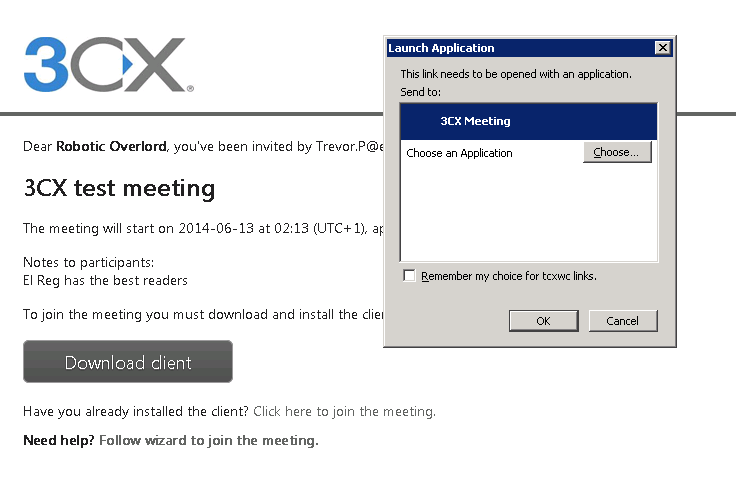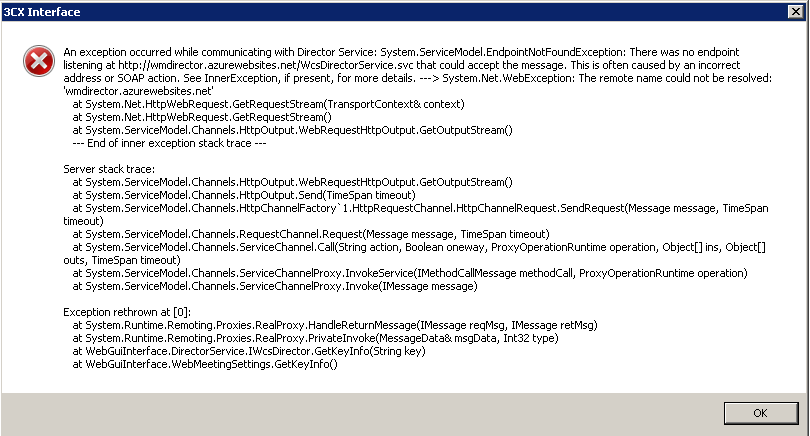Original URL: https://www.theregister.com/2014/06/16/3cx_webmeeting/
3CX WebMeeting: Not bad for a 1.0 product – just keep my phones out of the cloud
Our man puts comms kit through its paces
Posted in SaaS, 16th June 2014 10:09 GMT
Sysadmin blog 3CX has released its newest thing: WebMeeting. As I still had the virtual machines from my testing of its software PBX rattling around my lab, trying this latest offering seemed like a good plan. After some fits and starts it tested out well, better than I'd expect from a 1.0 product.
Unified communications is a space where I have been investing a lot of time. The big players seem to be Microsoft (Lync and Skype) and Cisco (CallManager and WebEx). There are any number of smaller players, from the nearby SIP provider I use (Planet Telecom) up to mid-sized organisations with great customer lists like 3CX itself.
I am both a full-time sysadmin and a full-time writer. To do both jobs I need a proper communications infrastructure to support my endeavours. I spend a lot of time on the phone in briefings, a lot of time doing interviews. I do a lot of web meeting demos, and live and breathe this stuff when I'm doing tech support.
In my searches, I've tried a lot of webinar products from a lot of different companies. Some, like ClickWebinar were unmitigated disasters, with a broken product and even worse support. Others, like WebEx, just work – but to call them "a little on the pricy side" is being "a little" generous.
What I want is the simplicity and cost-effectiveness of my (very accommodating) SIP provider, the unshakable public-facing webinar reliability of WebEx*, the technical support capabilities of TeamViewer and the global presence-based contact list capabilities of Skype – and all from a company I can trust.
Does 3CX offer this magical combination? No … but they're the closest I've worked with so far.
The basics
WebMeeting has two components. The first is an integration into your 3CX phone system server. This allows your staff who are running 3CX softphones to launch a web meeting with a few simple clicks. The second component lives in Microsoft Azure and is where most of the real heavy lifting takes place.
First you go to the conference tab. Next you "create a web meeting".
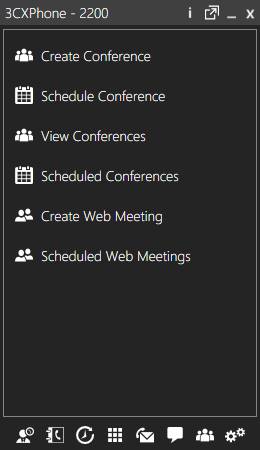 |
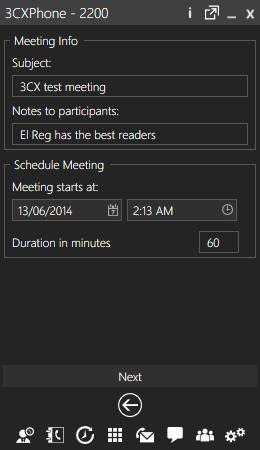 |
|
Don't forget to tell everyone what the meeting is about! (Click to enlarge screenshots) |
|
Select which options you require and upload any documents that you want attendees to have to hand. (A slide deck, perhaps, or a pre-briefing they should read.)
 |
 |
|
The options are few, but clear |
|
Select any participants internal to your organisation (ie: those who have accounts on the 3CX server that your instance of WebMeeting is tied to) and then add any external participants you wish to invite. You invite external participants by entering their name and email address.
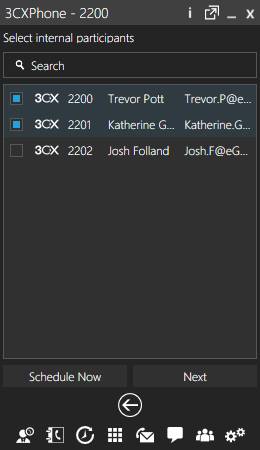 |
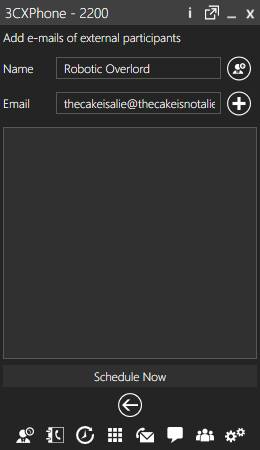 |
|
Obey your Robotic Overlord |
|
The Azure component of the exercise will then email everyone involved (all messages appears to pass through a Symantec messaging gateway on its way to participants). The email will include a calendar invite and a link to join the meeting. The emails sent to the host and the participants are almost identical.
If you don't have the 3CX client installed then clicking on the link in the email will prompt you to do so. Once installed you need to go back to the link in the email and click a link on the webpage to join the meeting. Unfortunately, if you are using a properly defended browser, the webpage can't sense that you have the application installed, so you get a great big "download client" button and a small, barely noticeable "click here to join the meeting" link. This needs to be bigger.
After that, the software launches, and it waits for the host to start the meeting.
The meeting software itself is … meeting software. Meeting software really hasn't changed much in about two decades.
My feelings for WebMeeting? It's complicated
Taken as a whole, 3CX has a shockingly good universal communications lineup. Its phone system is great, and its softphones are coming along nicely. WebMeeting really rounds out the offering by providing a visual communications capability that the phone system was sorely lacking, as well as whiteboard, desktop sharing, virtual classroom and basic remote support capabilities.
Taken as a whole, 3CX has a good product lineup, with each piece complimenting the next. Good, but not great: an issue present with all offerings throughout the industry.
3CX's weak spot is that WebMeeting is very young. It isn't nearly so feature rich as its competitors, and I honestly expect that a lot of people are going to want an all-star cast of "someone else" to go through the proverbial minefield ahead of them.
In a departure from the "you can run this all on your own infrastructure" aspect of 3CX's phone system, WebMeeting relies on Microsoft's Azure cloud to work. For small businesses this is probably a great move; Azure is likely to be more reliable than hosting it yourself. For something like webinars, which you will conduct with people outside your organisation, that's a good thing.
Unfortunately, running in Azure means you are not only losing control over a key component of your telecoms, you're handing it to the American government on a silver platter. That could be an issue for some companies – but for those folks, WebEx and other services are out too.
Avoiding the cloud: Point at foot, pull the trigger
Given my natural inclination towards worrying about privacy issues, it's easy to focus on the interdependence with the Azure-hosted component. The truth is that there is a strong case to be made for taking 3CX up on its all-hosted offering. Like all hybrid cloud telecommunications software, 3CX's WebMeeting has a certain fragility to it.
One of 3CX's biggest selling points is that its phone system is something you can run on your own infrastructure. You are in control. Of course, that also means you're in a position to screw things up. I fought WebMeeting for the better part of two weeks trying to get it to work only to realise the source of my errors was my own DNS system.
The primary DNS server in my test lab isn't an authoritative server. It uses a series of forwarders and secondary zones in large part because I am constantly creating and destroying domains in my lab. The primary DNS forwarder on my DNS server was down. It had been removed for maintenance a month earlier and I had forgotten to take it out of the forwarder sequence for the lab server.
What this meant was that the first DNS request for something simply wouldn't go through. It would time out and then the DNS server would switch to asking the secondary server. For a month, nothing else gave me any grief about this; apparently every other application is capable of asking twice.
WebMeeting didn't like this one bit. It blew up and cried about a DNS error, but of course when I looked up the DNS item in question it was there; my DNS server had just cached it! Fix the DNS server and bam, the whole system works like a charm.
This brings me to the discussion about 3CX as a cloud service. Any sane sysadmin won't run into this problem in production because he or she will run their telecommunications on dedicated infrastructure. From the external IP address right through to the database it should all be dedicated gear, and change-managed to the hilt. You don't mess with phones.
Unfortunately, there are a lot of people out there who will be tempted to run their phone systems as part of their "private cloud", where it will be exposed to regular change. To be honest, I don't think 3CX's WebMeeting is ready for that. It's a 1.0 product and they obviously have not yet discovered all the interesting ways it can fail.
Depending on how often people in your organisation use WebMeeting, a change that eventually breaks everything could go unnoticed for days or weeks at a time. Dedicated infrastructure would solve that, but so would using 3CX's hosted offering. If they tweak DNS and break WebMeeting for their users, they'll hear about it in minutes and thus have a far better chance of figuring out what caused the boo-boo.
Parting thoughts
All of my queasies with 3CX really boil down to paranoia. As a sysadmin I'm trained to avoid 1.0 products on general principle. I'm also leery about anything that puts any part of my telecoms data into the hands of the Americans, and I do consider webinar software to be part of that group.
What's amazing is that this is really the sum total of my gripes. Once you get it working, 3CX's software – from the phone system to the WebMeeting – really does "just work". It does the job, it does it well … the only bits left are features I'd like to add.
As a sysadmin, I'd like 3CX to basically graft Teamviewer into WebMeeting. I don't care about the presence information of people so much as the presence information of the devices they use. I like the Teamviewer option to view things on a per-device basis, and the rich suite of tools its 9.0 software has to offer the sysadmin.
I realise it's unfair to hold a unified communications package to Teamviewer's standard for desktop support. Nobody else has that level of oomph. What drives me with 3CX, however, is that it seems like a company that just might be convinced to do it anyways; they need differentiators, and I am still hunting that truly unified communications dream. ®
* Phones can go down. I don't care. There are at least three cell phones, two SIP phones and a landline in my house that I can use as backups. Webinars absolutely positively must work, every single time, no exceptions. The company's brand image depends on it.
